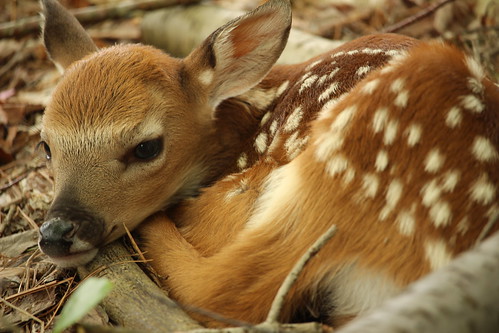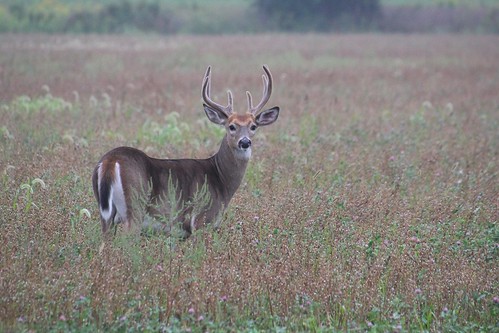There is something magical about seeing deer, especially with a group of children. Perhaps it is because they are so large compared to other animals likely to be seen. A deer sprinting away through the forest, leaping high with its white tail wagging, is inherently more impressive than the high pitched squeak a chipmunk makes before scurrying into an underground tunnel.
Winter is a hard time for deer. Easy to reach plants are often buried under the snow. The effort to dig for plants is often not worth it, so deer turn to other things. They eat twigs, tree buds, bark, pine needles, and other harder to digest foods. This changes their stomach biology to the point where a deer can die from eating other foods. To understand why, it’s helpful to know a bit about the deer stomach.
Deer have a four chambered stomach to make eating plants possible. They eat plant food rapidly, sending it to the first chamber of the stomach for storage. This food is then regurgitated to be chewed up before being sent to the second chamber, where it is digested by a horde of microbes that break down the tough plant materials. The deer then chew their food again before it goes into the third stomach, where water is absorbed before the final stomach digests the remaining plant materials.
The microbes are vital to this process. The dominant microscopic organisms in the deer stomach change over the year. Some microbes are good at digesting grassy, leafy materials, others are better at digesting fall apples and fruits and others are better at digesting bark. A sudden shift in the diet of a deer can overwhelm the microbe community in the stomach with food that is indigestible at that time of year.

In 2015, Outdoor Life reported “The New Hampshire Fish and Game Department today reported that twelve deer were discovered dead in South Hampton, N.H., on March 20, most likely the victims of well-intentioned, but tragically fatal, supplemental feeding by local residents.” The deer had died in good shape, but with full stomachs of undigestible food. Others died from a condition called “lactic acidosis,” another malady associated with winter feeding of carbohydrate rich food at a time when the deer cannot stomach carbohydrates.
Deer are impossible to avoid. They are everywhere: in our yards, in our neighborhoods, in the roads and, for some, in the freezer. Deer are one of the largest sources of wild meat in the area and man is now one of the only predators of deer in the region.
According to a report generated by the New York Department of Environmental Conservation, “…wolves and mountain lions, historically (deer’s) principal predators, have been eliminated. Bears, bobcats, and coyotes do prey on deer, particularly fawns, but hunting by humans is currently the primary predatory force acting to control population levels in rural and remote areas.”
This report, entitled “Deer Management in Urban and Suburban New York,” discusses in detail how too many deer can alter a forest, perhaps permanently. As deer eat the plants low to the ground and in the understory, young trees cannot get established, wildflowers disappear, and inedible invasive species out-compete native plants.
The trails at Audubon Community Nature Center provide a great example of that. Young trees have to be surrounded by fencing and tubes in order to grow and forest wildflowers are increasingly hard to find. Tall fences have been placed around some small areas of forest to show the difference between a deer-browsed forest and one where the deer can’t eat every edible plant they can reach. The difference inside the oldest fence is dramatic.
Unfortunately, the impact of deer does not stop at the plants. According to the NYDEC report: “The ecological changes brought about by deer also cascade through forest plant communities into wildlife communities, reducing the abundance and diversity of songbird species that use the intermediate levels of a forest.”
The report from the NYDEC goes into great detail about the problems that deer cause when their population is unchecked. These range from Deer Ticks to the economic impact of deer through car collisions and agricultural damage.
The long and short of it is that the landscape can only hold so many deer before they wreak havoc on the ecosystem. Without the natural predators that used to eat large numbers of deer, the DEC report states their population grows incredibly fast. “When there is plenty of food available, an average of 30-40% of the deer in a population have to die every year to keep the population from growing.” Unchecked, the number of deer grows far quicker than I had imagined.

I want to end this article the way it started. Deer are a magnificent animal to see. They are large, dynamic and seeing them is a joy. I love searching for fawns in the spring and observing them as they lay unmoving. I love watching the deer watch me with big, soft brown eyes as I walk past, indifferent to my presence.
The problem is, I also love the forest I walk through: the flowers, the birds, and the trees. In many areas, there are so many deer that they are using the plant resources that support them faster than the forest can create them. Research has made it clear that it is a choice: we can have a somewhat diverse forest ecosystem or we can lower the deer population. No way has yet been discovered to have both.
Audubon Community Nature Center builds and nurtures connections between people and nature. ACNC is located just east of Route 62 between Warren and Jamestown. The trails are open from dawn to dusk as is Liberty, the Bald Eagle. The Nature Center is open from 10 a.m. until 4:30 p.m. daily except Sunday when it opens at 1 p.m. More information can be found online at auduboncnc.org or by calling (716) 569-2345.


Recent Comments